Evaluation of the Water Shielding Performance of a Capillary Barrier System through a Small-Scale Model Test
Abstract
1. Introduction
2. Characteristic of the CB System
3. Soil Samples and Water Retention Characteristics
3.1. Soil Samples
3.2. Water Retention Characteristics
4. Laboratory SSCB Model Test under the Lateral No-Flow Condition
4.1. Apparatus and Conditions of the SSCB Model Test
4.2. Production of the SSCB Model
4.3. Preparation for the SSCB Model Test
4.4. Infiltration Behavior in the SSCB Model Test
4.4.1. Result for Case 1
4.4.2. Result for Case 2
4.4.3. Result for Case 3
4.4.4. Measurement Results of the Diversion Lengths in the SSCB Model Test
4.5. Diversion Length on the SSCB Model Test
5. Summaries and Conclusions
- The inside of the SSCB model proposed in this study was 45.5 cm long, 47.0 cm high, and 15.0 cm wide. Notably, the amount of drainage water under the lowest tested rainfall intensity (I = 20 mm/h) reached a steady state within 6 h. We can hence infer that the production work and the testing results of the SSCB model were better when the testing time was relatively short. Moreover, since this model was smaller than the large-scale models described in previous works, it was expected that its production work and testing would have a lower cost.
- The following rainfall intensities were achieved during the SSCB model tests: 20 mm/h (Case 1), 50 mm/h (Case 2), and 100 mm/h (Case 3). The time required by the sand layer to reach the saturation state in each of the above cases was 180 min, 85 min, and 45 min, respectively; moreover, breakthroughs occurred at 210 min, 85 min, and 45 min, respectively. Thus, the rainfall intensity was very closely related both to the time required by the sand layer to reach the saturation state and to the time of breakthrough occurrence in the CB system.
- The diversion lengths in the SSCB model test of this study were measured based on two criteria (i.e., LUD1: at the interface between the sand and the gravel layers, and LUD2: the occurrence point of the finger flow at the height of the soil moisture sensors (No. 3 and No. 4) installed in the gravel layer), because water infiltration occurred irregularly from the interface between the sand and the gravel layers. The LUD1 values obtained for Case 1, Case 2, and Case 3 were 13.5 cm, 11.7 cm, and 0 cm, respectively; meanwhile, the LUD2 values were 24.8 cm, 11.2 cm, and 0 cm, respectively. These results indicate that LUD1 and LUD2 were 13.3% and 54.8% lower, respectively, in Case 2 (I = 50 mm/h) than those in Case 1 (I = 20 mm/h). Finally, in Case 3, under the extreme rainfall intensity of 100 mm/h, our CB system collapsed.
- The diversion lengths (LD) under the lateral flow condition were estimated by the empirical equation of Steenhuis et al. [28] based on the hydraulic conductivity functions and soil-water characteristic curves of the sand and gravel. In Case 1, Case 2, and Case 3, they were 145.5 cm, 56.8 cm, and 27.7 cm, respectively. However, considering that the lengths of ΔL1 and ΔL2 would be reduced by the occurrence of breakthroughs in the SSCB model test, the effective diversion lengths (i.e., LED1 and LED2) for the real CB system were derived. The LED1 and LED2 values in Case 1, Case 2, and Case 3 were 114.2 and 125.5 cm, 23.7 and 23.1 cm, and −17.1 and −17.1 cm, respectively. Here, negative LED1 and LED2 values (i.e., −17.1 cm and −17.1 cm in Case 3) indicated that there is no water-shielding performance of the CB system under extreme rainfall (i.e., I = 100 mm/h).
- The diversion lengths in the CB system were compared: LD (estimated by the empirical equation) and LED1 and LED2 (estimated based on the SSCB model test). The results indicated that LED1 and LED2 were lower than the correspondent LD values, and that their reduction reflected the differences in rainfall intensity between one case and the other: the LED1 and LED2 values were 21.5% and 13.8% (Case 1), or 58.3% and 59.2% (Case 2) lower, respectively, than the correspondent LD values. Thus, when the effective diversion lengths based on the SSCB model test are applied to the real CB system design, it is expected that since the reduced water-shielding performance of the CB system is taken into account, and the stability of the CB slope will be further improved. In addition, since the LED1 and LED2 values have a slight difference, applying the average of the two values to the CB system design may be a reasonable suggestion.
Funding
Institutional Review Board Statement
Informed Consent Statement
Data Availability Statement
Conflicts of Interest
References
- Miyazaki, T. Water flow in unsaturated soil in layered slopes. J. Hydrol. 1988, 102, 201–214. [Google Scholar] [CrossRef]
- Rasmuson, A.; Eriksson, J.C. Capillary Barriers in Covers for Mine Waste Dumps; Report 3307; The National Swedish Environmental Protection Board: Stockholm, Sweden, 1986. [Google Scholar]
- Nicholson, R.V.; Gillham, R.W.; Cherry, J.A.; Reardon, E.J. Reduction of acid generation in mine tailings through the use of moisture-retaining cover layers as oxygen barriers. Can. Geotech. J. 1989, 26, 1–8. [Google Scholar] [CrossRef]
- Ross, B. The diversion capacity of capillary barriers. Water Resour. Res. 1990, 26, 2625–2629. [Google Scholar] [CrossRef]
- Nyhan, J.W.; Schofield, T.G.; Starmer, R.H. A Water Balance Study of Four Landfill Cover Designs Varying in Slope for Semiarid Regions. J. Environ. Qual. 1997, 26, 1385–1392. [Google Scholar] [CrossRef]
- Kämpf, M.; Montenegro, H. On the performance of capillary barriers as landfill cover. Hydrol. Earth Syst. Sci. 1997, 1, 925–930. [Google Scholar] [CrossRef]
- Khire, M.V.; Benson, C.H.; Bosscher, P.J. Capillary barriers: Design variables and water balance. J. Geotech. Geoenviron. Eng. 2000, 126, 695–708. [Google Scholar] [CrossRef]
- Bussière, B.; Aubertin, M.; Chapuis, R.P. The behavior of inclined covers used as oxygen barriers. Can. Geotech. J. 2003, 40, 512–535. [Google Scholar] [CrossRef]
- Parent, S.É.; Cabral, A. Design of inclined covers with capillary barrier effect. Geotech. Geol. Eng. 2006, 24, 689–710. [Google Scholar] [CrossRef]
- Corey, J.C.; Horton, J.H. Influence of Gravel Layers on Soil Moisture Content and Flow; Du Pont de Nemours (EI) and Co.: Aiken, SC, USA; Savannah River Lab.: Jackson, SC, USA, 1969. [Google Scholar] [CrossRef][Green Version]
- Hill, D.E.; Parlange, J.Y. Wetting front instability in layered soils. Soil Sci. Soc. Am. J. 1972, 36, 697–702. [Google Scholar] [CrossRef]
- Morel-Seytoux, H.J. Dynamic perspective on the capillary barrier effect at the interface of an upper fine layer with a lower coarse layer. In Engineering Hydrology; ASCE: Reston, VA, USA, 1993; pp. 467–472. [Google Scholar]
- Baker, R.S.; Hillel, D. Laboratory tests of a theory of fingering during infiltration into layered soils. Soil Sci. Soc. Am. J. 1990, 54, 20–30. [Google Scholar] [CrossRef]
- Walter, M.T.; Kim, J.S.; Steenhuis, T.S.; Parlange, J.Y.; Heilig, A.; Braddock, R.D.; Selker, J.S.; Boll, J. Funneled flow mechanisms in a sloping layered soil: Laboratory investigation. Water Resour. Res. 2000, 36, 841–849. [Google Scholar] [CrossRef]
- Tami, D.; Rahardjo, H.; Leong, E.C.; Fredlund, D.G. A physical model of sloping capillary barriers. Geotech. Test. J. 2004, 27, 11–27. [Google Scholar] [CrossRef]
- Aubertin, M.; Cifuentes, E.; Apithy, S.A.; Bussière, B.; Molson, J.; Chapuis, R.P. Analyses of water diversion along inclined covers with capillary barrier effects. Can. Geotech. J. 2009, 46, 1146–1164. [Google Scholar] [CrossRef]
- Rahardjo, H.; Santoso, V.A.; Leong, E.C.; Ng, Y.S.; Tam, C.P.H.; Satyanaga, A. Use of recycled crushed concrete and Secudrain in capillary barriers for slope stabilization. Can. Geotech. J. 2013, 50, 662–673. [Google Scholar] [CrossRef]
- Tang, J.; Taro, U.; Huang, D.; Xie, J.; Tao, S. Physical Model Experiments on Water Infiltration and Failure Modes in Multi-Layered Slopes under Heavy Rainfall. Appl. Sci. 2020, 10, 3458. [Google Scholar] [CrossRef]
- Boulanger-Martel, V.; Bussière, B.; Côté, J. Insulation covers with capillary barrier effects to control sulfide oxidation in the Arctic. Can. Geotech. J. 2021, 58, 583–594. [Google Scholar] [CrossRef]
- Barth, C.; Wohnlich, S. Proof of effectiveness of a capillary barrier as surface sealing of sanitary landfill. In Proceedings of the 7th International Waste Management and Landfill Symposium, Santa Margarita di Pula, Cagliari, Italy, 4–8 October 1999; pp. 389–392. [Google Scholar]
- Ng, C.W.; Liu, J.; Chen, R.; Xu, J. Physical and numerical modeling of an inclined three-layer (silt/gravelly sand/clay) capillary barrier cover system under extreme rainfall. Waste Manag. 2014, 38, 210–221. [Google Scholar] [CrossRef]
- Zhan, T.L.; Li, H.; Jia, G.W.; Chen, Y.M.; Fredlund, D.G. Physical and numerical study of lateral diversion by three-layer inclined capillary barrier covers under humid climatic conditions. Can. Geotech. J. 2014, 51, 1438–1448. [Google Scholar] [CrossRef]
- Matsumoto, K.; Kobayashi, K.; Morii, T.; Nakajusa, S. Evaluation of diversion length of the capillary barrier with nonflatness of regular sine wave shape between sand and gravel layers. Jpn. Geotech. J. 2016, 11, 305–313. (In Japanese) [Google Scholar] [CrossRef][Green Version]
- Park, T.W.; Kim, H.J.; Tanvir, M.T.; Lee, J.B.; Moon, S.G. Influence of coarse particles on the physical properties and quick undrained shear strength of fine-grained soils. Geomech. Eng. 2018, 14, 99–105. [Google Scholar] [CrossRef]
- Oldenburg, C.M.; Pruess, K. On numerical modeling of capillary barriers. Water Resour. Res. 1993, 29, 1045–1056. [Google Scholar] [CrossRef]
- Bussière, B.; Aubertin, M.; Chapuis, R.P. A laboratory set up to evaluate the hydraulic behavior of inclined capillary barriers. In Proceedings of the International Conference on Physical Modelling in Geotechnics, St. John’s, NL, Canada, 10–12 July 2002; pp. 391–396. [Google Scholar]
- Morris, C.E.; Stormont, J.C. Evaluation of numerical simulations of capillary barrier field tests. Geotech. Geol. Eng. 1998, 16, 201–213. [Google Scholar] [CrossRef]
- Steenhuis, T.S.; Parlange, J.-Y.; Kung, K.-S. Comment on “The diversion capacity of capillary barriers” by Benjamin Ross. Water Resour. Res. 1991, 27, 2155–2156. [Google Scholar] [CrossRef]
- Bossi, G.; Borgatti, L.; Gottardi, G.; Marcato, G. The Boolean Stochastic Generation method-BoSG: A tool for the analysis of the error associated with the simplification of the stratigraphy in geotechnical models. Eng. Geol. 2016, 203, 99–106. [Google Scholar] [CrossRef]
- Pasculli, A.; Calista, M.; Sciarra, N. Variability of local stress states resulting from the application of Monte Carlo and finite difference methods to the stability study of a selected slope. Eng. Geol. 2018, 245, 370–389. [Google Scholar] [CrossRef]
- Sekhavatian, A.; Choobbasti, A.J. Comparison of Point Estimate and Monte Carlo probabilistic methods in stability analysis of a deep excavation. Int. J. Geo-Eng. 2018, 9, 1–19. [Google Scholar] [CrossRef]
- Likos, W.J.; Lu, N. Hysteresis of capillary stress in unsaturated granular soil. J. Eng. Mech. 2004, 130, 646–655. [Google Scholar] [CrossRef]
- Henry, E.J. Analytical and numerical modeling assessment of capillary barrier performance degradation due to contaminant-induced surface tension reduction. J. Geotech. Geoenviron. Eng. 2007, 133, 231–236. [Google Scholar] [CrossRef]
- Fredlund, D.G.; Xing, A. Equations for the soil-water characteristic curve. Can. Geotech. J. 1994, 31, 521–532. [Google Scholar] [CrossRef]
- Stormont, J.C. The effectiveness of two capillary barriers on a 10% slope. Geotech. Geol. Eng. 1996, 14, 243–267. [Google Scholar] [CrossRef]
- Stormont, J.C.; Morris, C.E. Method to estimate water storage capacity of capillary barriers. J. Geotech. Geoenviron. Eng. 1998, 124, 297–302. [Google Scholar] [CrossRef]
- Porro, I. Hydrologic behavior of two engineered barriers following extreme wetting. J. Environ. Qual. 2001, 30, 655–667. [Google Scholar] [CrossRef]
- Abdolahzadeh, A.M.; Lacroix Vachon, B.; Cabral, A.R. Evaluation of the effectiveness of a cover with capillary barrier effect to control percolation into a waste disposal facility. Can. Geotech. J. 2011, 48, 996–1009. [Google Scholar] [CrossRef]
- Kenney, T.; Chahal, R.; Chiu, E.; Ofoegbu, G.; Omange, G.; Ume, C. Controlling constriction sizes of granular filters. Can. Geotech. J. 1985, 22, 32–43. [Google Scholar] [CrossRef]
- Dallo, Y.A.; Wang, Y. Determination of controlling constriction size from capillary tube model for internal stability assessment of granular soils. Soils Found. 2016, 56, 315–320. [Google Scholar] [CrossRef]
- Morris, C.E.; Stormont, J.C. Parametric study of unsaturated drainage layers in a capillary barrier. J. Geotech. Geoenviron. Eng. 1999, 125, 1057–1065. [Google Scholar] [CrossRef]
- Kung, K.-J.S. Preferential flow in a sandy vadose soil: 2. Mechanism and implications. Geoderma 1990, 46, 59–71. [Google Scholar] [CrossRef]
- Kojima, M.; Miyazaki, T. Diversion capacity of capillary barriers on curved boundary slopes. Trans. JSIDRE 2004, 232, 395–402. (In Japanese) [Google Scholar] [CrossRef]
- Morii, T.; Takeshita, Y.; Inoue, M.; Matsumoto, S. Field measurement of rainfall infiltration in capillary barrier of soil and determination of its divergence length. Trans. Jpn. Soc. Irrig. 2010, 77, 559–565. (In Japanese) [Google Scholar] [CrossRef]
- ASTM D2434-68. Standard Test Method for Permeability of Granular Soils (Constant Head) (Withdrawn 2015); ASTM International: West Conshohocken, PA, USA, 2006. [CrossRef]
- Kim, B.S.; Hatakeyama, M.; Park, S.W.; Park, H.S.; Takeshita, Y.; Kato, S. Assessment of water retention test by continuous pressurization method. Geotech. Test. J. 2021, 44, 274–289. [Google Scholar] [CrossRef]
- Warrick, A.W.; Wierenga, P.J.; Pan, L. Downward water flow through sloping layers in the vadose zone: Analytical solutions for diversions. J. Hydrol. 1997, 192, 321–337. [Google Scholar] [CrossRef]
- Fredlund, D.G.; Xing, A.; Huang, S. Predicting the permeability function for unsaturated soils using the soil-water characteristic curve. Can. Geotech. J. 1994, 31, 533–546. [Google Scholar] [CrossRef]
- Childs, E.C.; Collis-George, N. The permeability of porous materials. Proc. R. Soc. Lond. Ser. A Math. Phys. Sci. 1950, 201, 392–405. [Google Scholar] [CrossRef]
- Kobayashi, K.; Matsumoto, K.; Nakajusa, S.; Morii, T. Effect of the nonwoven fabric laying to give to diversion length of the capillary barrier. Jpn. Geotech. J. 2013, 8, 611–620. [Google Scholar] [CrossRef]

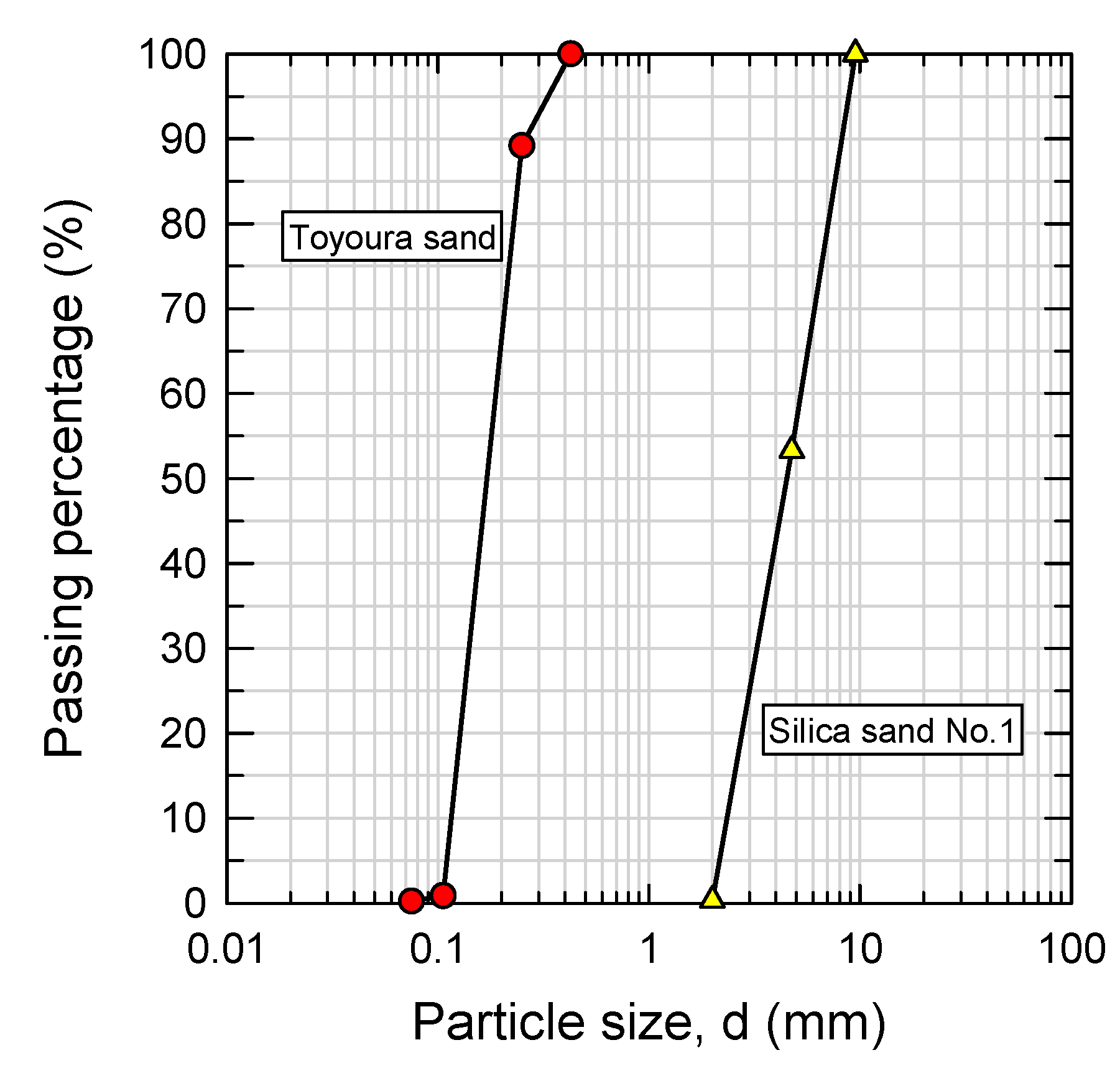
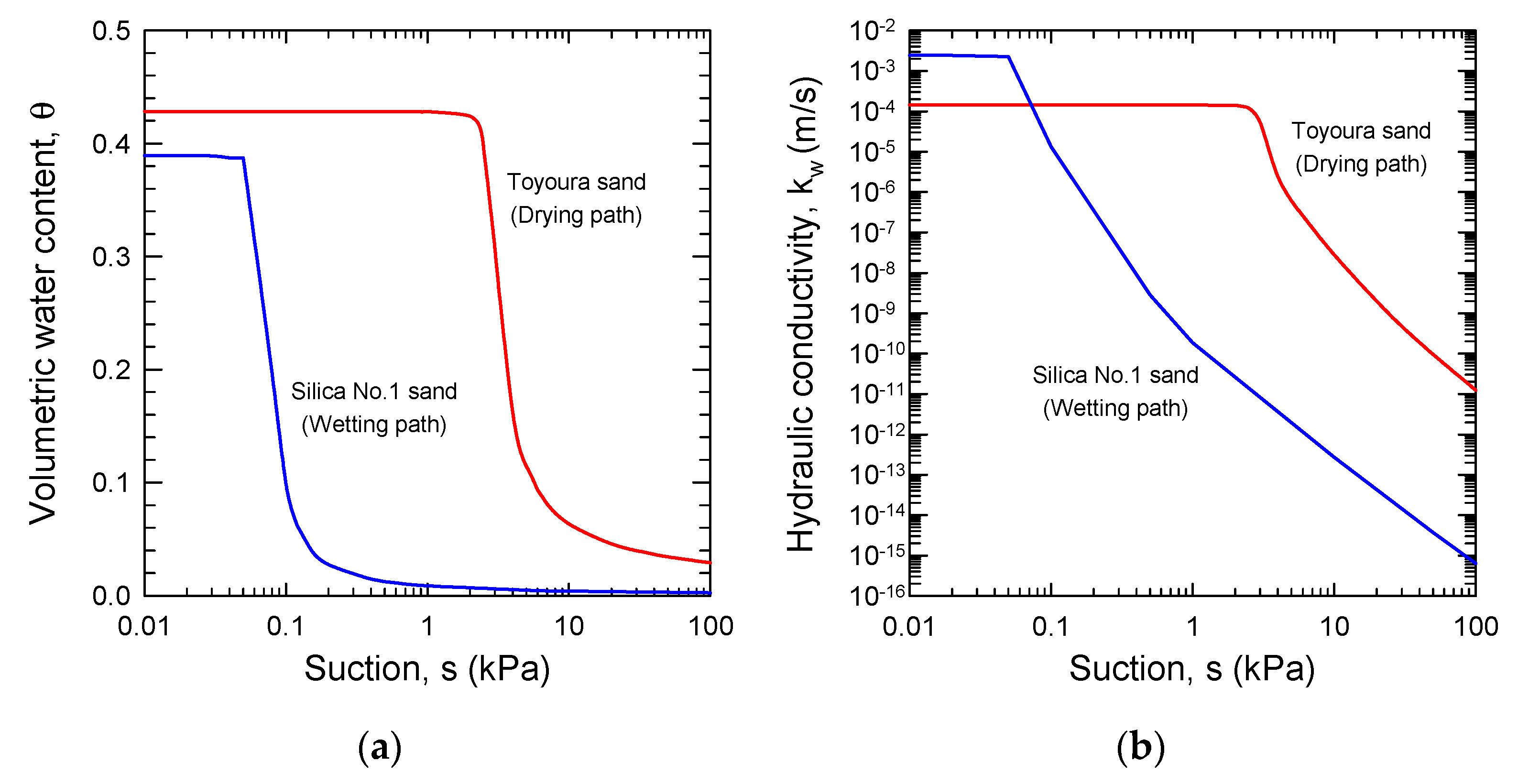
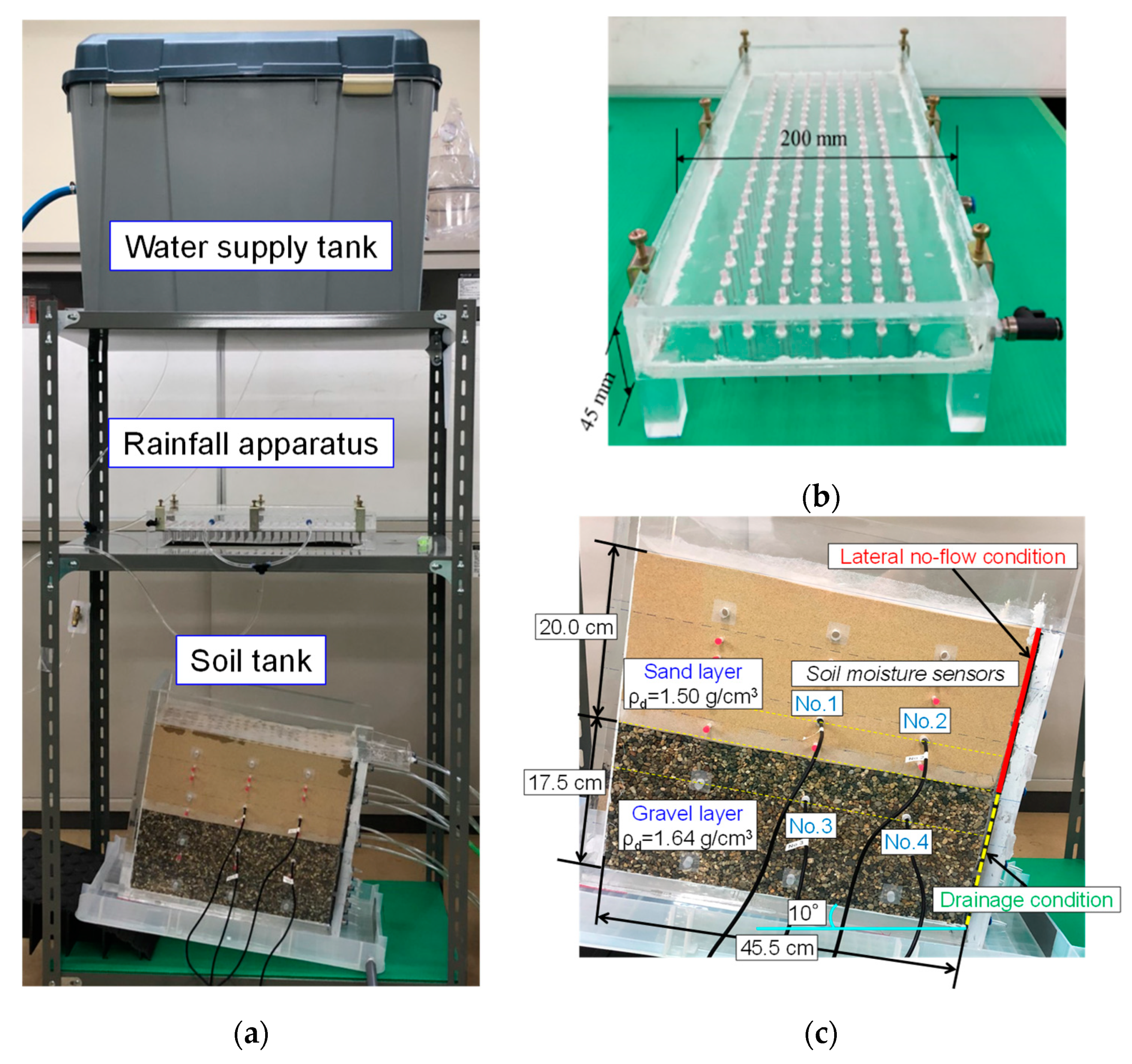
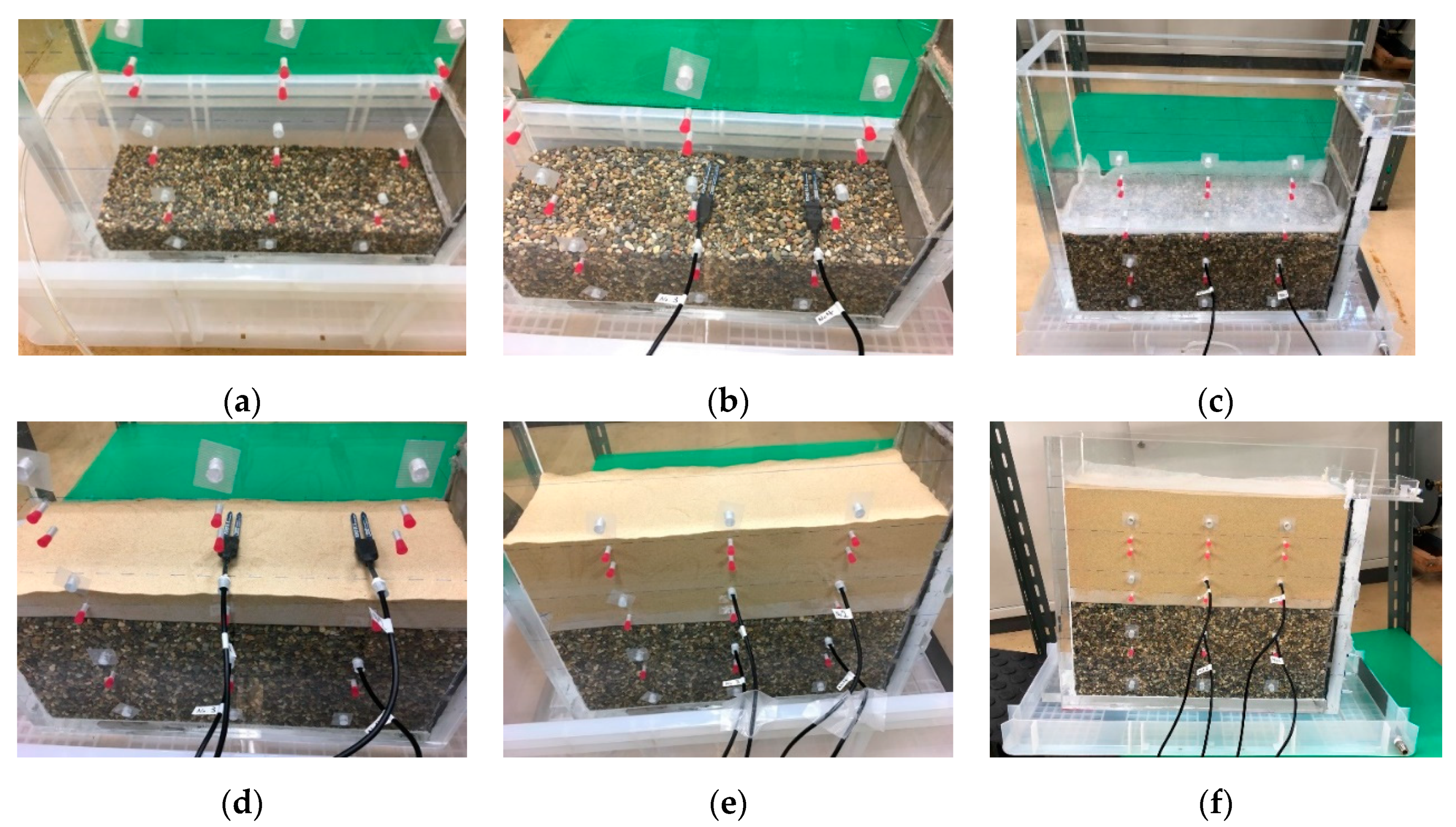
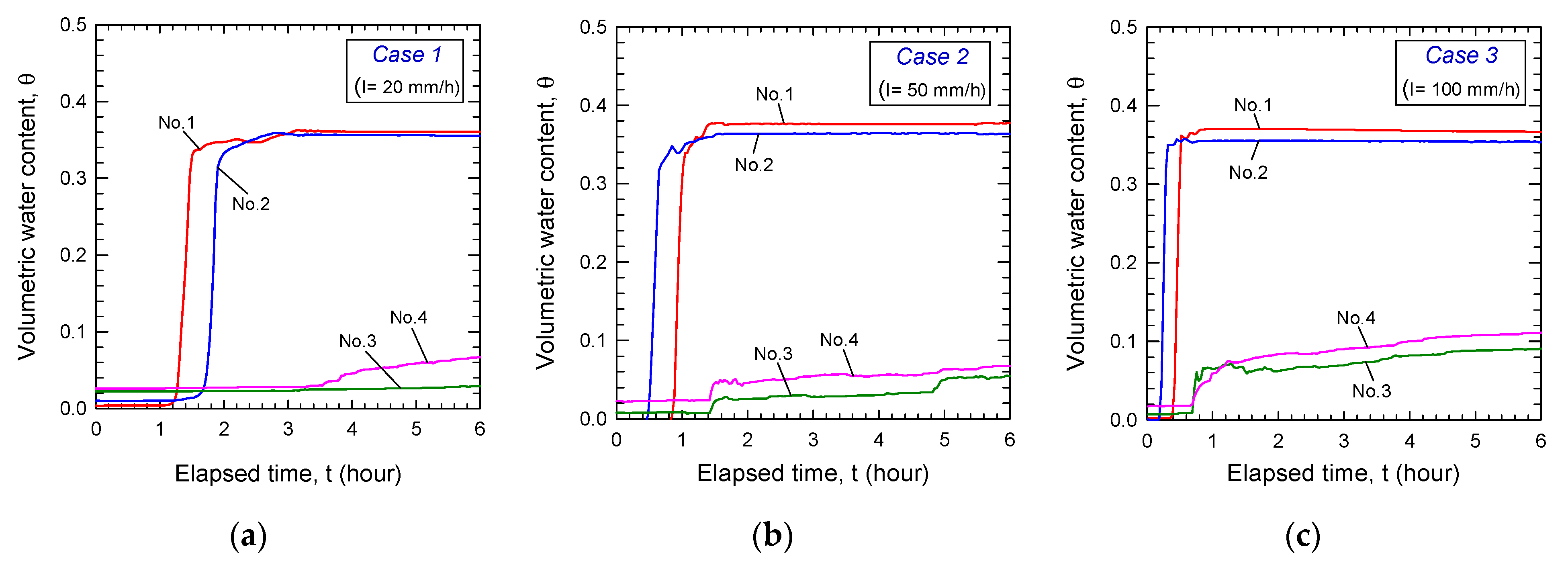

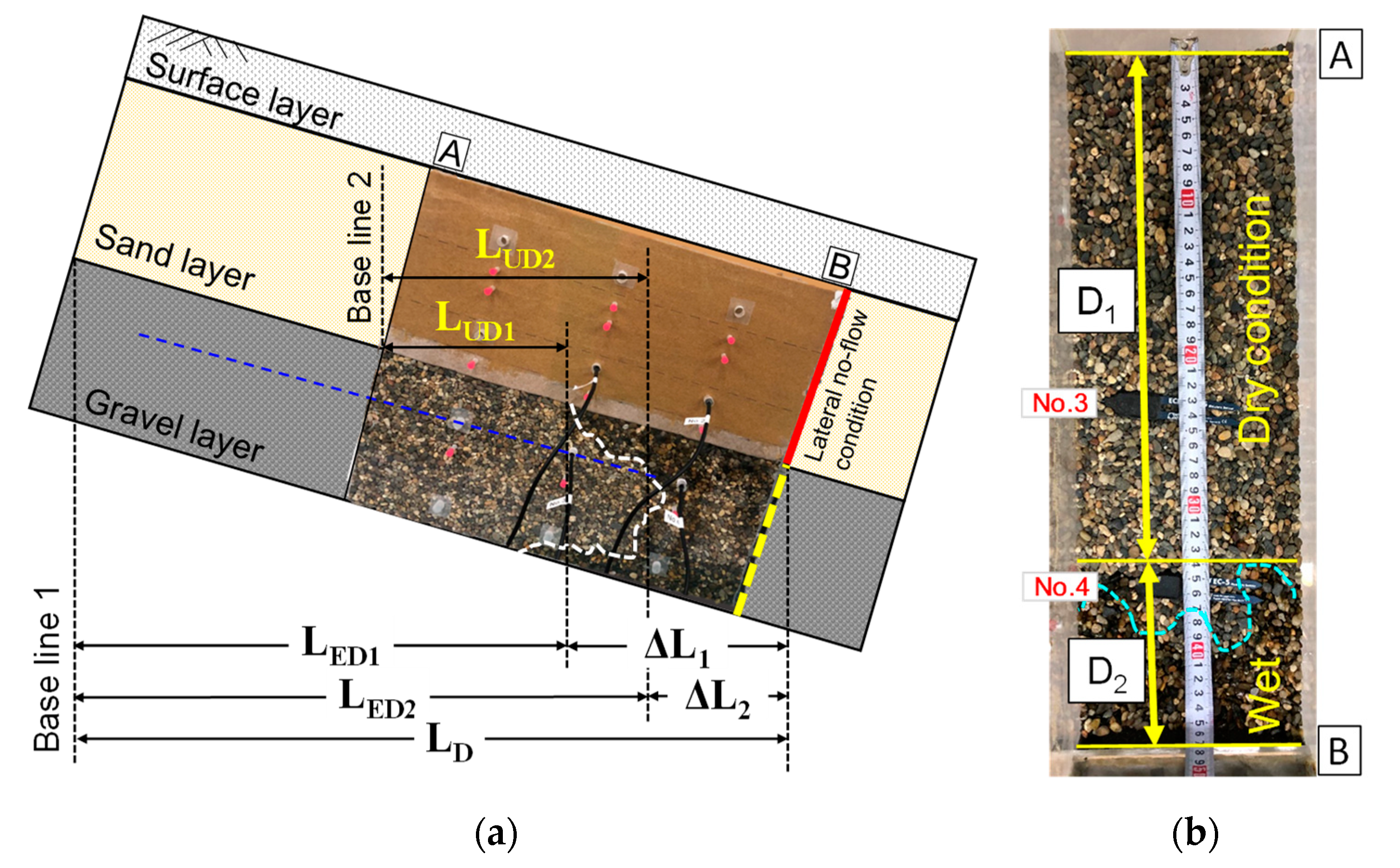

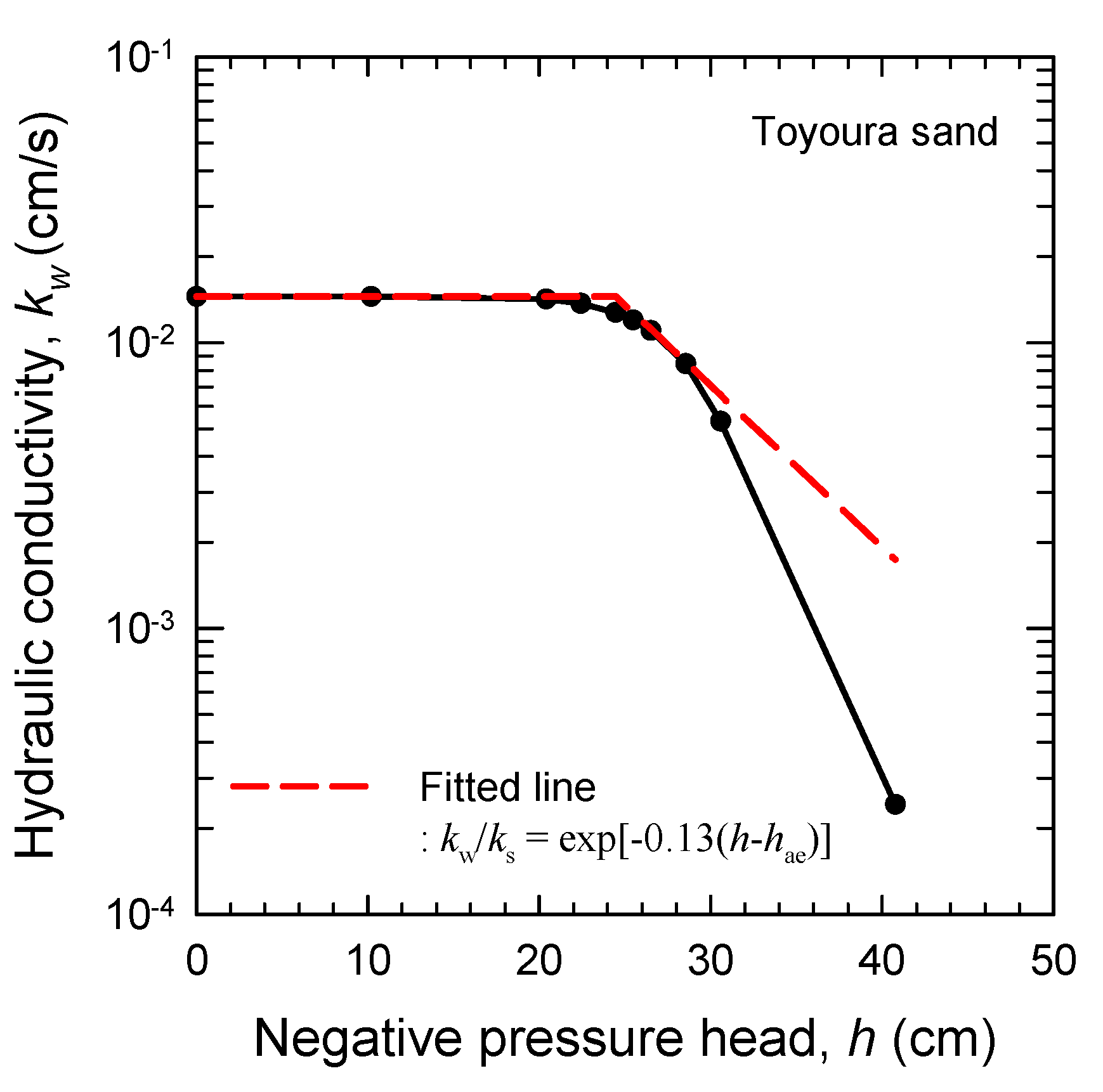
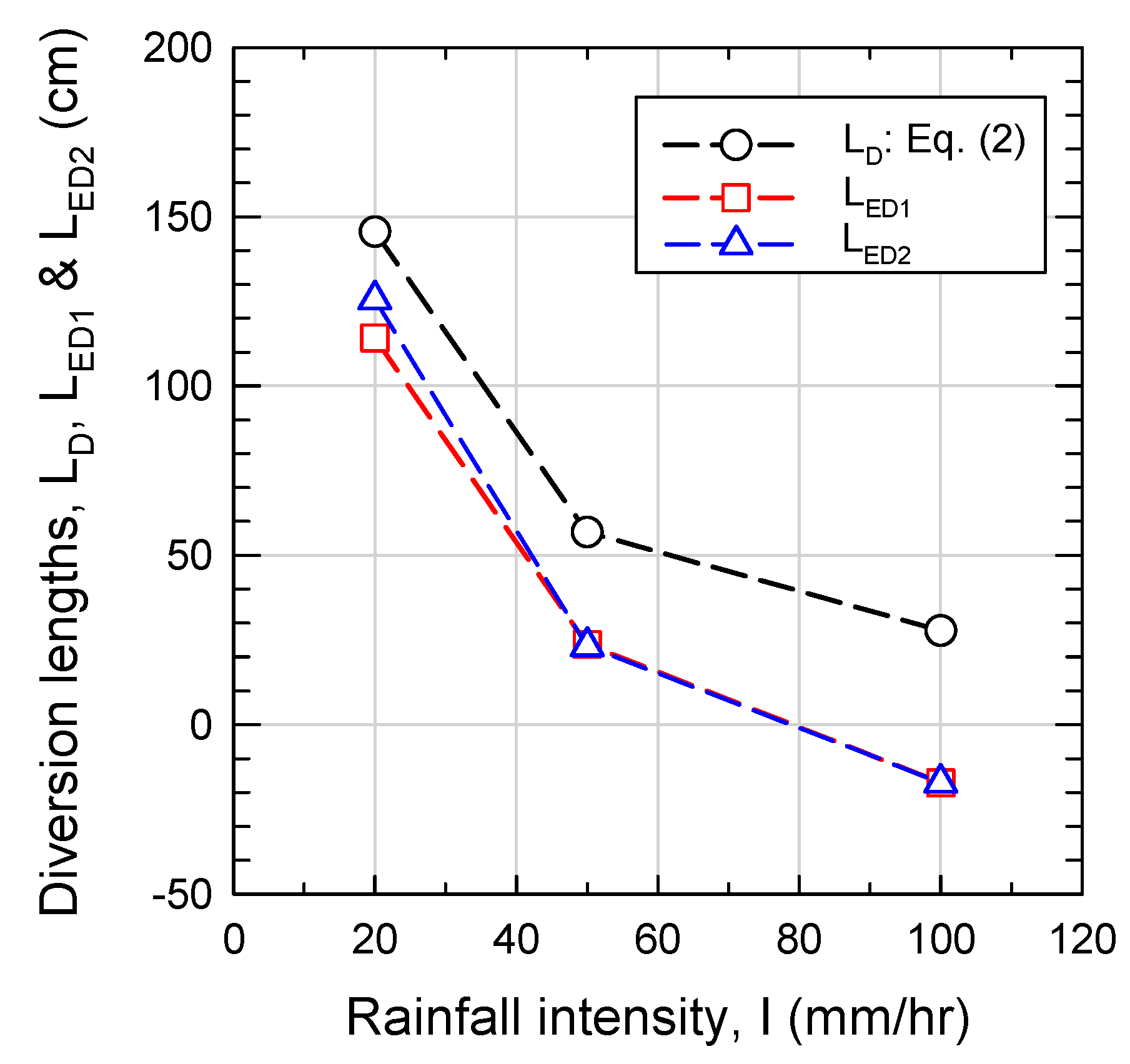
| Sample | Toyoura Sand | Silica Sand No. 1 |
|---|---|---|
| Soil particle density, ρs (g/cm3) | 2.64 | 2.65 |
| Mean particle size, D50 (cm) | 1.69 | 4.65 |
| Maximum dry density, ρd max (g/cm3) | 1.64 | 1.67 |
| Minimum dry density, ρd min (g/cm3) | 1.37 | 1.45 |
| Uniformity coefficient, Cu | 1.63 | 2.24 |
| Curvature coefficient, Cc | 0.97 | 0.84 |
| Relative density, Dr (%) in the CB model test | 53.8 | 87.9 |
| Saturated hydraulic conductivity, ksat (m/s) | 1.45 × 10−4 | 2.44 × 10−3 |
| Soil Sample | θs | AEV | EX | a | n | m |
|---|---|---|---|---|---|---|
| Toyoura sand | 0.432 | 2.45 | - | 2.80 | 10.02 | 0.75 |
| Silica sand No. 1 | 0.389 | - | 0.05 | 0.39 | 0.015 | 0.07 |
| Case No. | Case 1 | Case 2 | Case 3 | |
|---|---|---|---|---|
| Sand layer | Initial dry density, ρdi (g/cm3) | 1.50 | 1.50 | 1.50 |
| Initial water content, wi (%) | 0.64 | 1.11 | 0.33 | |
| Initial volumetric water content, θi | 0.01 | 0.02 | 0.01 | |
| Gravel layer | Initial dry density, ρdi (g/cm3) | 1.64 | 1.64 | 1.64 |
| Initial water content, wi (%) | 0.87 | 1.19 | 1.30 | |
| Initial volumetric water content, θi | 0.01 | 0.02 | 0.02 | |
| Drainage material: nonwoven fabric | Material (Fiber cross-section: ◎) | -Outside: polyethylene -Inside: polyester | ||
| Thickness (mm) | 0.13 | |||
| Hydraulic conductivity for vertical plane (m/s) | 1.30 × 10−3 | |||
| Rainfall intensity, I (mm/h) | 20 | 50 | 100 | |
| Slope angle, Φ (°) | 10 | 10 | 10 | |
| Measurement time (h) | 6 | 6 | 6 | |
| No. | I (mm/h) | Time to Reach the Saturation State of the Sand Layer | Time of Breakthrough Occurrence |
|---|---|---|---|
| Case 1 | 20 | 180 min | 210 min |
| Case 2 | 50 | 85 min | 85 min |
| Case 3 | 100 | 45 min | 45 min |
| Case No. | Case 1 | Case 2 | Case 3 | |
|---|---|---|---|---|
| Rainfall intensity, I (mm/h) | 20 | 50 | 100 | |
| Lateral nonflow condition | Measured LUD1 (cm) | 13.5 | 11.7 | 0 |
| Measured LUD2 (cm) | 24.8 | 11.2 | 0 | |
| Lateral flow condition | Estimated LD (cm) by Equation (2) | 145.5 | 56.8 | 27.7 |
| ΔL1 (cm) | 31.3 | 33.1 | 44.8 | |
| ΔL2 (cm) | 20.0 | 33.6 | 44.8 | |
| Effective diversion length, LED1 (cm) | 114.2 | 23.7 | −17.1 | |
| Effective diversion length, LED2 (cm) | 125.5 | 23.1 | −17.1 | |
| qv (mm/h) | ksat (cm/s) | κ | b | Φ (°) | hae (cm) | haex (cm) | LD (cm) |
|---|---|---|---|---|---|---|---|
| 20 | 1.45 × 10−2 | 0.038 | 0.13 | 10 | 24.5 | 0.5 | 145.5 |
| 50 | 0.096 | 56.8 | |||||
| 100 | 0.192 | 27.7 |
Publisher’s Note: MDPI stays neutral with regard to jurisdictional claims in published maps and institutional affiliations. |
© 2021 by the author. Licensee MDPI, Basel, Switzerland. This article is an open access article distributed under the terms and conditions of the Creative Commons Attribution (CC BY) license (https://creativecommons.org/licenses/by/4.0/).
Share and Cite
Kim, B.-S. Evaluation of the Water Shielding Performance of a Capillary Barrier System through a Small-Scale Model Test. Appl. Sci. 2021, 11, 5231. https://doi.org/10.3390/app11115231
Kim B-S. Evaluation of the Water Shielding Performance of a Capillary Barrier System through a Small-Scale Model Test. Applied Sciences. 2021; 11(11):5231. https://doi.org/10.3390/app11115231
Chicago/Turabian StyleKim, Byeong-Su. 2021. "Evaluation of the Water Shielding Performance of a Capillary Barrier System through a Small-Scale Model Test" Applied Sciences 11, no. 11: 5231. https://doi.org/10.3390/app11115231
APA StyleKim, B.-S. (2021). Evaluation of the Water Shielding Performance of a Capillary Barrier System through a Small-Scale Model Test. Applied Sciences, 11(11), 5231. https://doi.org/10.3390/app11115231






